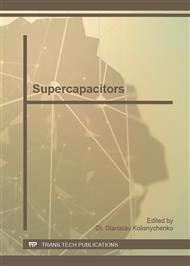p.2617
p.2621
p.2629
p.2634
p.2638
p.2643
p.2653
p.2657
p.2666
Supercapacitive Properties of Hydrothermally Synthesized γ-MnOOH Nanowires
Abstract:
γ-MnOOH nanowires have been synthesized via a simple hydrothermal process without any template at relatively low temperature. The as-obtained sample was characterized by X-ray diffraction (XRD) and scanning electron microscopy (SEM). The electrochemical properties of the γ-MnOOH nanowires were investigated by cyclic voltammetry and galvanostatic charge-discharge methods. And a high specific capacitance calculated from the galvanostatic discharge curve was 191 F•g-1 at the current density of 0.1 A•g-1, which remain a good specific capacitance of 143 F•g-1 at the current density of 1.0 A•g-1. The electrochemical analysis results demonstrate that γ-MnOOH nanowires should be a good candidate as electrode material for supercapacitor.
Info:
Periodical:
Pages:
2638-2642
Citation:
Online since:
January 2013
Authors:
Keywords:
Price:
Сopyright:
© 2013 Trans Tech Publications Ltd. All Rights Reserved
Share:
Citation:



